Droughts & Floods: How Weather Extremes Damage Your Foundation
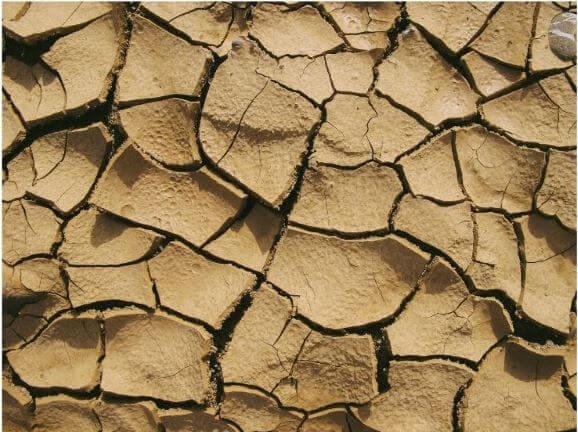
Originally posted 7/9/20; updated 9/14/23
In the Midwest, it’s not unusual to have the air conditioning on at the start of a day, only to switch over to heat at the end of it (or vice versa). This is particularly common in the spring and fall when a major cold/hot front can roll through the area and cause temperature fluctuations of 20 degrees or more.
Weather extremes affect more than your HVAC usage, however. If the earth around your foundation dries out during a severe drought or becomes oversaturated from a heavy thunderstorm, this can create major problems for your home’s stability.
Acculevel is a family-owned and operated company that specializes in foundation repair and waterproofing. We’ve been helping homeowners preserve and protect their homes since our start in 1996, and we want to do the same for you.
We want you to know the signs to watch for so that you can detect these issues as soon as they develop. In most cases, the earlier you make repairs, the less expensive those repairs will be.
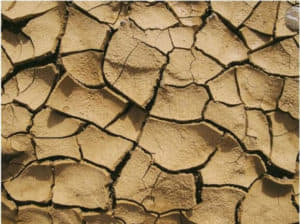 This is an example of expansive soil during a severe drought.
This is an example of expansive soil during a severe drought.
How Can Drought Cause Foundation Problems?
When the ground around your home dries out, it begins to shrink. The particles of dirt are smaller without water. This allows the dirt to become more compact, shrinking away from your home’s foundation. If the soil shrinks enough, it can shift or “settle” under the foundation.
Your Soil Type Can Make Drought Conditions Worse
Soil shrinkage is the most problematic if you have clay soil. This is an accurate statement, but it may bring up more questions than it answers. So let’s back up a bit. Do you know what type of soil you have? In the Midwest, you normally have one of two soil types: granular or expansive.
Granular soil has more sand or gravel in it, which allows it to stack together like rocks. It doesn’t pack together when it’s wet, and it crumbles easily when it’s dry. Water moves through it relatively easily, so it’s less likely to be impacted by drought damage. Generally speaking, if you have granular soil, your biggest problem will be erosion, not drought.
Expansive Soil is clay-dominant and more susceptible to both hydrostatic pressure and drought. Clay-heavy soil can be molded or shaped when wet and on dry summer days will crack like a dropped piece of pottery. Clay particles in soil act like sheets of paper, stacking tightly together. Water seeps through it more slowly because the clay particles have to separate before the water will pass. This separation means water is more likely to collect, so the soil expands. It also means the water evaporates over time and causes the soil to contract or sink.
Your Foundation Type is Also a Risk Factor
If you have a “shallower” foundation, soil shrinkage is more of an issue. By shallow, I am referring to the foundations under porches, patios, garages, and crawl spaces. These foundations are only a few feet deep, so when the soil shrinks, it pulls away along most (if not all) of the foundation depth. This makes it more likely that the soil underneath your foundation will be affected.
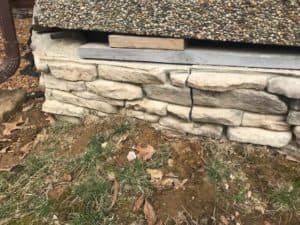 This photo of a settling porch was taken by an Acculevel project manager during a free estimate appointment. The homeowners have wedged boards in the gap.
This photo of a settling porch was taken by an Acculevel project manager during a free estimate appointment. The homeowners have wedged boards in the gap.
Signs That Drought is Creating Foundation Problems
A foundation that settles rapidly or unevenly is a serious problem that can impact your home’s entire structure. If you notice signs of uneven settling around your house, take action promptly.
The major signs fall into three basic categories:
- Doors and windows: when your foundation shifts, it pulls at the structural wood framing of your house. This means the door and window frames start to move off-center, creating issues with how smoothly the doors and windows will open or close. This is commonly referred to as “sticking,” but it can be more than just trouble with opening entrances. The doors may not latch, or the windows might slide shut on their own.
- Drywall Damage: like your door and window frames, structural shifts will strain the drywall until it breaks. Cracks above sticking doors or windows are common.
- Cracks in the Foundation or in the Exterior of Your House: these can be cracks in the block or in a brick facade overlay. As the ground settles, the foundation struggles to support the weight of your house.
Helical Piers Stabilize and Secure Settling Home Foundations
If you have any of these symptoms, your home needs professional help. Helical piers are the best and safest solution for a settling home’s foundation; you can read more about piers and their costs here.
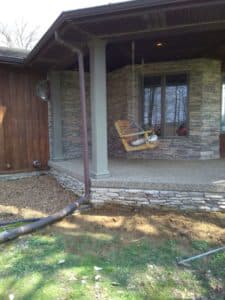 The same porch as above, now with piers installed. This photo was taken by an Acculevel crew member after work was completed.
The same porch as above, now with piers installed. This photo was taken by an Acculevel crew member after work was completed.
Flooding Can Also Damage a Home’s Foundation
If you live in an area with a high water table or your area has been inundated with heavy rains, there may be more water in the ground than the soil can absorb.
How Does Too Much Water Create Foundation Issues?
Water accumulates in the soil and fully saturates the ground. Then, when the next rain comes, there’s nowhere for the water to go. So it starts pushing against your foundation, which is now functioning like a dam to keep the water out.
As the water accumulates, the pressure forming against your foundation walls increases. This is what’s referred to as hydrostatic pressure in our industry. The force of the pressure can cause foundation damage, as well as water intrusion.
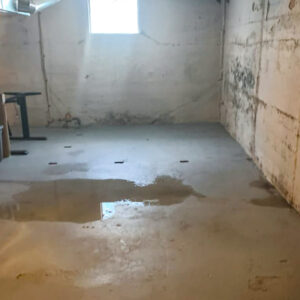
This photo was taken by an Acculevel project advisor during a free in-home evaluation. Water is seeping into the basement at the cove joint (where the wall & floor connect).
Signs of Moisture Damage in Your Home’s Foundation
Water collecting in your basement or crawl space is an obvious sign that foundation damage is occurring. But you may experience other, more subtle indications that you have moisture issues:
Cracks of Any Kind: thin, wandering, “hairline” cracks are the first sign that trouble is brewing. If you have any of these, we recommend having these professionally repaired using an epoxy fill. It can be easy to dismiss small hairline cracks, but you have to remember that once a crack forms, it is not going to mend itself. It will only widen over time.
Musty or Stale Odors: your foundation is made of porous material (concrete, brick, or stone), and this means water can seep into it. It’s highly likely that your home will have water inside the walls before it enters the interior of your basement or crawl space. Damp walls lead to mold, mildew, and other biological growths that create a distinctive smell that should alarm homeowners.
Bowing or Buckling Walls: if the exterior walls of your foundation are starting to lean inward, you need to take action immediately. This is a clear indication that hydrostatic pressure is creating major foundation damage and you need an expert to evaluate your home ASAP.
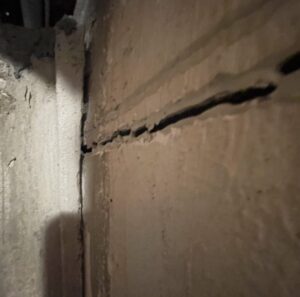
This photo was taken by an Acculevel project advisor during a free in-home evaluation. The basement wall has cracked and is beginning to bow inward.
Foundations Affected by Water Can Be Repaired
There’s more than one way to deal with problems caused by rain, soil moisture, and damp foundations. Waterproofing is critical for water intrusion, but if you don’t have water inside your home yet, improving your guttering could be a helpful option. We recommend that downspouts drain a minimum of ten feet away from your home.
Bowing walls need immediate action, and the best repair method depends on how far the wall has moved.
Do You Need Foundation Repairs For Your Home?
Whether your foundation is struggling with droughts or floods, Acculevel has the solution you need! If you live in our service area, give us a call and we’ll send one of our experienced project advisors to your home. They will evaluate your foundation condition and recommend the best course of action for you to keep your home strong and healthy for years to come.
If you live outside the Midwest, you’ll need to find another experienced and reputable contractor. Use our free checklist of questions to ask a contractor to ensure they are the right company for you.